
by Sara E. Pratt Tuesday, March 15, 2016
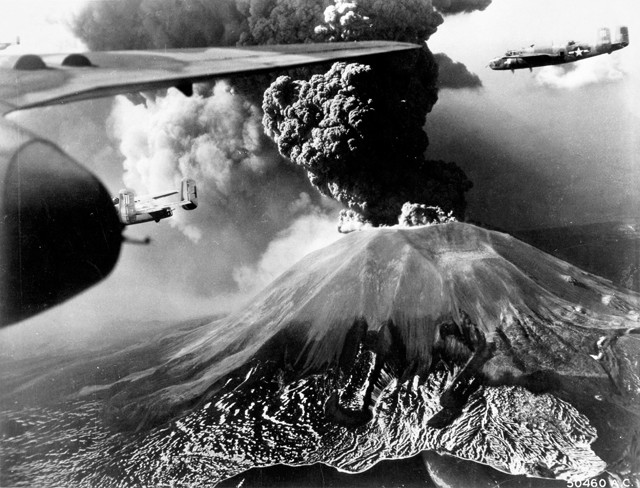
Mount Vesuvius last erupted in March 1944, seven months after the Allied invasion of Italy. Credit: National Archives.
Four-and-a-half years into World War II, the residents of San Sebastiano, Italy — a Neapolitan village on the western slopes of Mount Vesuvius — had already endured much misery: dictatorial rule, invasion, occupation and bombings. In mid-March 1944, they faced yet another catastrophe, this one a natural disaster that would destroy their town.
On March 17, Mount Vesuvius began an eruption that, over the ensuing week and a half, rained down rocks the size of basketballs, covered some areas with up to a meter of ash, and released a slow-moving wall of volcanic rock, lava and debris that crushed and burned everything in its path. U.S. newsreels recorded the eruption and the evacuation of San Sebastiano’s residents, who, assisted by Allied soldiers, piled household goods and belongings onto wagons as lava advanced toward the village.
The 1944 eruption of Vesuvius, the volcano’s most recent, occurred 72 years ago this month. It was the worst eruption of the volcano since 1872, 72 years prior. Of course, the most famous eruption in the volcano’s long history occurred in A.D. 79, when, after a century of inactivity, Vesuvius unleashed voluminous clouds of hot gas and ash along with rock and pyroclastic flows that entombed Herculaneum and Pompeii, killing an estimated 30,000 people.
No activity has been observed since 1944, except for several flank collapses inside the caldera that have raised false alarms of an impending eruption. But living with a quiescent volcano is still hazardous. In May 1998, after 30 hours of continuous rain, ash deposits from previous eruptions turned into debris flows near the town of Sarno, about 15 kilometers from Vesuvius, killing 150 people.
Vesuvius is arguably one of the longest-studied volcanoes in the world. Researchers who keep a watchful eye on Vesuvius have learned much about its eruptive history, its cycles and relationships to Apennine seismicity, and its magmatic connections to the nearby volcanic system of Campi Flegrei (“Fields of Fire”). Continued research will bear critically on the future safety of the roughly 3 million people who live on and near the volcano’s slopes. The city of Naples is just 12 kilometers away — a distance, as volcanologist Erik Klemetti has noted , that can be traversed by a pyroclastic flow in about two and a half minutes.
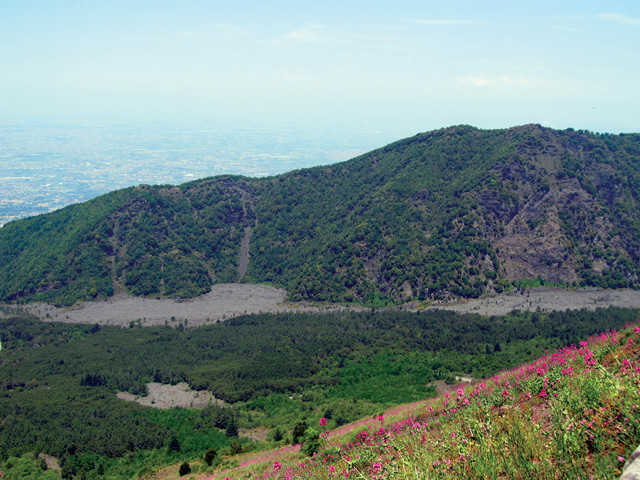
A hardened lava stream from the 1944 eruption. Credit: Daryl Mitchell, CC BY-SA 2.0.
On the day of the A.D. 79 eruption, 17-year-old Pliny the Younger stayed behind with his mother on Cape Misenum, a headland on the northwest edge of the Bay of Naples, while his uncle, Pliny the Elder, a navy commander, took ships across the bay in an attempt to rescue people caught in the eruption’s wake. Many escaped thanks to Pliny the Elder’s efforts, but he died on the beach after suffering a respiratory attack triggered by breathing volcanic gases. Pliny the Younger’s account of the eruption and description of its towering mushroom-shaped ash cloud later led geologists to coin the terms “Vesuvian” or “Plinian” to categorize similar large, explosive eruptions.
But even Vesuvius does not always have Vesuvian eruptions. Between A.D. 79 and 1944, Vesuvius experienced 27 significant eruptions . The 1944 eruption, like eight of the 10 previous eruptions, was effusive-explosive, combining flowing lava with violent expulsions of rock and ash. The other two were purely effusive, including one in 1855 that sent a lava flow into San Sebastiano. The last explosive eruption of Vesuvius occurred on Aug. 8, 1779, ejecting lava fountains up to a kilometer above the crater.
The 1944 eruption ejected 0.01 cubic kilometers of material, ranking it a 3 on the Volcanic Explosivity Index , which ranges from zero to 8 and is based largely on the volume of ejecta. By comparison, the A.D. 79 eruption was a VEI 5, the same as the 1980 Mount St. Helens eruption. A VEI-4 eruption of Vesuvius in 1631 ejected 0.2 to 1.1 cubic kilometers of material, some of which fell 1,200 kilometers away in Constantinople (now Istanbul, Turkey), and killed an estimated 4,000 people.
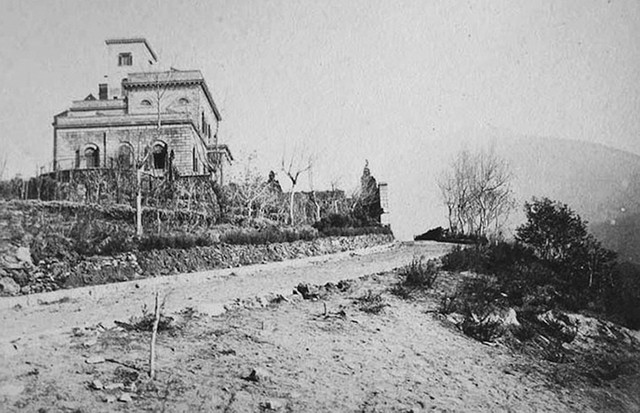
The Royal Vesuvius Observatory, founded in 1841 by King Ferdinand II of Bourbon, is the oldest volcanological observatory in the world. The building, now a museum, survived eruptions in 1850, 1855, 1861, 1868, 1872, 1906, 1929 and 1944 without being damaged. Credit: Vesuvius Observatory.
Vesuvius sputtered to life again in early 1944, belching smoke and cinders and emitting lava within the caldera; it first sent lava flowing down the western slopes toward Naples on March 17. The next few days brought rumbling, roaring and ground shaking, as lava, tephra and volcanic bombs were ejected from the crater.
The sound was exactly like artillery fire," a New York Times writer who was perhaps more accustomed to covering the war noted on March 20. Two days later, he described the lava’s assault from the town of Cercola: “Smashing through San Sebastiano and Massa di Somma on a broadening, though generally slowing, front, the Vesuvian lava flow tonight had resulted in the evacuation of this town of 7,000 two miles to the northwest.”
After the Allied invasion of Italy in the fall of 1943, U.S. and British forces had advanced north from the beachheads at Salerno and taken Naples and the surrounding countryside but fighting continued in the north. With the Italian government in disarray, it was the U.S. military that took command of public safety and the evacuations.
An analysis in the January 2007 Journal of Historical Geography concluded that “despite all the problems of wartime, management of the emergency by Allied Control Commission was both impressive at the time and holds important lessons about the manner in which eruptions may be handled in the future.”
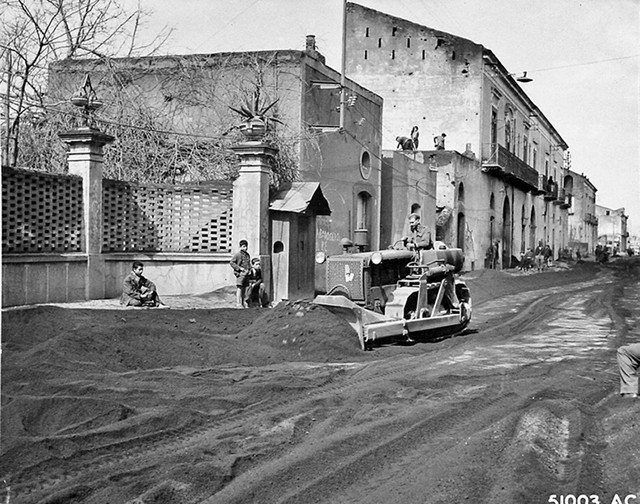
Allied forces managed the evacuations, cleanup and much of the rebuilding of the villages struck by Vesuvius. Credit: National Archives.
The paper also notes that despite the chaos and confusion, geologist Giuseppe Imbò, director of the Royal Vesuvius Observatory, managed to continue making observations. Imbò’s work is also mentioned in the March 20 New York Times article, which describes the “green-trousered and excitable little professor” who maintained an office in the observatory “halfway to the crater” as having “crawled in the darkness to the edge of the lava stream” the night before.
Two days later, the Times reported that the Italian king Victor Emmanuel III visited San Sebastiano and “chatted in English 45 minutes” with the Allied Military Government public safety officer, Lt. Col. John A. Warner, who had been superintendent of the New York State Police before the war. “The King’s arrival was a surprise to Col. Warner and the handful of Italians left in the southern fringe of the town, which the lava flow entered Monday night [March 19] and destroyed yesterday.”
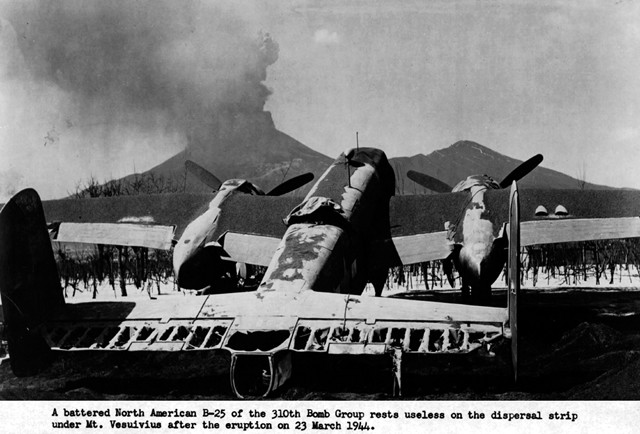
The eruption destroyed dozens of B-25 bombers of the U.S. Army Air Force's 340th Bombardment Group stationed at Pompeii Airfield. Credit: National Archives.
On the other side of the volcano from San Sebastiano, at Pompeii Airfield in Poggiomarino, a few kilometers east of the base of Vesuvius near the town of Terzigno, the U.S. Army Air Force’s 340th Bombardment Group at first thought they would not need to evacuate. The unit’s experiences with Vesuvius are described in a series of diary entries written by Sgt. Robert F. McRae.
On March 20, 1944, he wrote: “As I sit in my tent … I can hear at four- to 10-second intervals the loud rumbling of the volcano on the third day of its present eruption. The noise is like that of bowling balls slapping into the pins on a giant bowling alley. To look above the mountain tonight, one would think that the world was on fire. The thickly clouded sky glows like that above a huge forest fire. Glowing brighter as new spouts of flame and lava are spewn from the crater. As the clouds pass from across the top of the mountain, the flame and lava can be seen shooting high into the sky to spill over the sides and run in red streams down the slopes. … Today it is estimated that a path of molten lava 1 mile long, half a mile wide, and 8 feet deep is rolling down the mountain. Towns on the slopes are preparing to evacuate. Our location is, apparently, safe. At any rate no one here, civilian or Army authorities, seems too much worried. Lava has not started to flow down this side of the mountain as yet but is flowing on the other side toward Naples.”
But their luck would soon change — something for which the unit was known. The unit’s unlucky reputation — famously noted in the 1961 novel “Catch-22” by author Joseph Heller (who joined the 340th as a B-25 bombardier in May 1944 on Corsica, where the unit was relocated after the eruption) — was based largely on the high fatality rates for bomber crews. But it was also exacerbated by its encounter with Vesuvius.

Vesuvius has a long eruptive history and, being just 12 kilometers from downtown Naples, threatens a large population. Credit: Antonsusi, CC BY-SA 2.0.
On March 21, McRae wrote: “At about 5:30 p.m. small streams of lava began running down our side of the mountain. The first on this side. Soon many swift, fiery streams were flowing in all directions. The rumbling continues — more prolonged now. This evening it would seem that the whole top of the mountain is burning. Fiery patches here and there resemble a log which is just burning out. Heavy explosions occur followed by prolonged rumbling while sparks and molten lava are thrown high into the air to fall like rain on all sides of the cone.”
McRae didn’t write again until March 29. In the intervening eight days, the crews had been evacuated to a nearby airfield where they spent a frigid night in a tobacco shed, leaving their airplanes behind. McRae, part of the team sent to inspect the damage, later reported “almost complete devastation” with “tents torn to ribbons” and “88 B-25 Mitchells — $25 million worth of aircraft … a total loss.”
The damage to the bombers, some of which were ultimately repaired and returned to service, was not reported in the U.S. press until late April. Germany, however, was aware of the losses earlier. In a mid-April diary entry, McRae noted that Axis Sally, an American who broadcast German propaganda from Berlin, said that Vesuvius had decimated the 340th Bomb Group. “Actually a sprained wrist and a few minor cuts were the only casualties,” he wrote.
While Vesuvius claimed no military fatalities during the 1944 eruption, 26 Italian civilians were killed and nearly 12,000 were displaced. Most died near Salerno, where heavy ashfall collapsed roofs. Falling volcanic rock killed three in Terzigno. And in San Sebastiano, hot ash boiled a water tank, which exploded, killing two children.
The Next One When Vesuvius next erupts, the toll could be much greater, which is why the volcanologists of Italy’s National Institute of Geophysics and Volcanology have made Mount Vesuvius one of the most watched volcanoes in the world.
Today, the Royal Vesuvius Observatory building perched high on the volcano’s flank that was once occupied by Giuseppe Imbò is a museum. But volcanologists no longer need to crawl to the edge of a lava stream in order to monitor the volcano; they have at their disposal a wide variety of remote sensors that measure seismic activity, ground deformation, gravimetric and magnetic field variations, soil and groundwater temperatures, and the composition of gases emitted from fumaroles.
Such continuous monitoring, it is hoped, will make it possible for researchers to provide a short-term forecast that would allow at least two weeks’ notice of an impending eruption — the time required to evacuate the nearly 600,000 people living within a 15-kilometer radius who are considered most at risk. Included in this so-called “red zone ” is the village of San Sebastiano, which was rebuilt after the 1944 eruption.
© 2008-2021. All rights reserved. Any copying, redistribution or retransmission of any of the contents of this service without the expressed written permission of the American Geosciences Institute is expressly prohibited. Click here for all copyright requests.